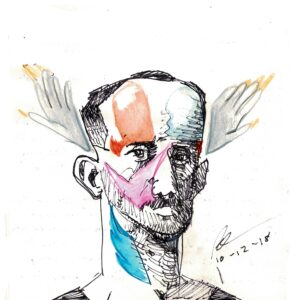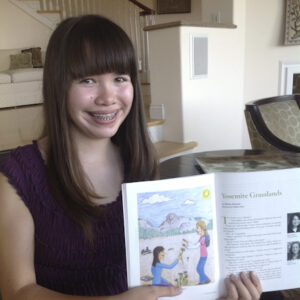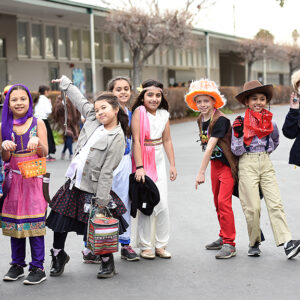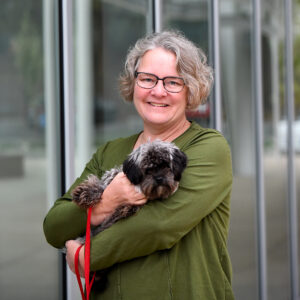This story was originally published in the Summer 2017 edition of Harker Magazine.
Early 20th century French painter Henri Matisse, who left an indelible mark on modern art, once said, “It would be a mistake to ascribe this creative power to an inborn talent. In art, the genius creator is not just a gifted being but a person who has succeeded in arranging for their appointed end, a complex of activities, of which the work is the outcome. The artist begins with a vision – a creative operation requiring an effort. Creativity takes courage.”
These sentiments are seamlessly woven into the fabric of Harker’s progressive visual arts curricula. “A student’s effort is paramount in grading their progress in whatever course they take with me,” explained Pilar Agüero-Esparza, upper school visual arts teacher, who received the William Hyde and Susan Benteen Irwin Scholarship for proven excellence in the arts during her undergraduate days at the University of California, Santa Cruz. She went on to earn her master’s degree in spatial art from San Jose State University.
“I do not believe that only students who already have an aptitude for the visual arts – either through innate characteristics or due to prior experience with classes – can do well and get A’s,” Agüero-Esparza said. “I believe that anyone can learn to draw by studying the mechanics, learning techniques and, inevitably, practicing. This is where effort and an open attitude to learn is what becoming a great artist is all about.”
At Harker, the visual arts take the form of yearlong required courses, single-semester electives, Advanced Placement and honors classes, after-school activities and summer programs – all of which are designed to foster creativity, self-expression, imagination, critical thinking, problem-solving, confidence, open-mindedness, curiosity, risk-taking and time management.
Through art, students of all ages learn how to view and interpret the world around them – and find out more about themselves along the way. As with academic and extracurricular offerings in acting, dance and choreography, directing, instrumental music, musical theater, technical theater and vocal music, instruction covers not only artmaking but also art history, theory, criticism and appreciation.
Led by K-12 visual arts department chair Jaap Bongers and K-5 assistant chair Gerry-louise Robinson, faculty members on all four campuses include both postgraduate educators and professional artists, specializing in architecture, ceramics, collage, design, drawing, filmmaking, painting, photography, printmaking, sculpture, stone carving and textiles.
Starting With a Blank Canvas
At Harker Preschool, whether inside cozy cottage classrooms or their very own art studio, Harker’s littlest learners precociously begin their individual journey toward self-expression, experimenting with a wide range of media and materials that put their critical thinking and fine motor skills to the test. As they engage in intentional play through a series of handson, developmentally appropriate projects in ceramics, collage, drawing, painting, weaving and wire working, they exhibit curiosity, intrinsic motivation, creative problem-solving, aesthetic valuing, sorting, counting, sequencing and much more.
“The arts foster a deeper understanding of our uniquely human existence,” said preschool visual arts specialist Alexandria Kerekez. “We can process our experiences, reinforce our knowledge, and come to know ourselves by creating and enjoying art. Children learn about the world as it is by making observations, thinking representationally and developing new skills with multiple tools. Most notably, they can come to imagine the world as it can be through open-ended art experiences that allow them to express their feelings and ideas in an environment with no wrong answers.”
At just 3, 4 and 5 years of age, when it comes to their own creations, these tiny artists are given free rein – from ideation to evaluation. Kerekez, who holds a bachelor’s degree in creative arts and a master’s degree in education and social justice, refers to her role as “the guide on the side.”
“It is important to me that the children’s ideas inspire the topics of their research and that they choose the materials for its execution. It is my role to facilitate the activities and suggest helpful techniques and proper usage of their chosen tools. They are the leaders of their own creative destinies,” said Kerekez, who is currently working on a personal project of threedimensional mixed-media sculptures soon to be installed in common areas in and around San Jose. “All student artwork is assessed by the artist who created it. During every visit to the art studio, a reflection time is carved into the schedule. This is a time for the young artists to express their ideas, explain their processes, make aesthetic evaluations and plan for future works,” Kerekez noted.
Exploring the Elements
Kindergartners and first graders, encouragingly guided by Peggy Lao, lower school visual arts teacher, are introduced gradually to the elements of art, including color, form, line, shape, space, texture and value. Before they begin to dabble in ceramics, collage, drawing and printmaking, students watch closely and listen carefully as Lao offers step-by-step demonstrations.
“I like to use a follow-the-leader type of guided teaching with the younger students,” said Lao. “I demonstrate a step, then the students do the step on their own papers. This method is good for time management, and it allows students to process and execute a step at a time, rather than having to accomplish too much in a short time,” she said. “Once they begin to work, students must learn to be flexible as they change their ideas, take the initiative to seek help and guidance, and, above all, strive to be confident with their own personal creativity by not comparing to others.”
Robinson, who leads Harker’s second through fifth grade art classes and previously taught in Australia, her native Ireland and the United Kingdom, adheres to a variety of engaging teaching styles intended for different ages and abilities, including one-on-one instruction and teacher-led direct instruction. She even creates instructional videos that students can view at home, which means more time making art at school. “I also incorporate music, books, magazines, visual aids and, of course, lots of demonstrations,” she added.
Students in Robinson’s classes are exposed to the principles of design – balance, emphasis, harmony, hierarchy, proportion, and similarity and contrast – as they study art movements and periods throughout history, conduct independent research, enjoy gradelevel field trips to local art museums and build 3-D works of art. After-school activities include workshops and open studio time, and Robinson teaches arts and crafts as part of Harker’s summer programming.
Since art is open to aesthetic interpretation, “evaluation is based not on product but on process,” Robinson said. “While we do have a guideline, observing how a student handles each step of a project from beginning to end is where the assessment will derive from.”
For middle schoolers to succeed in Elizabeth Saltos’ visual art classes, where visual learning and bigpicture, right-brain thinking is all the rage. Students must “participate in every lesson and immerse themselves in the experience, take chances, make mistakes, go beyond the predictable visual solutions, and come up with something completely unique from their previous pieces, personally empowering, expressive and connected to themselves,” Saltos said. She is also the middle school’s Art Club faculty advisor.
Saltos’ students practice and develop their conceptual, technical and visual perceptual skills as they create two- and three-dimensional works of art, including drawings, paintings, ceramics and sculpture. They continue to cultivate their own aesthetic and personal imagery, interpret style and theme, and study various artists, art movements, cultures and historical periods. After school, they can let their imaginations run wild with workshops, Art Club and open studio time.
“Visual learners use art directly to analyze, deconstruct and synthesize elements of a problem to reassemble parts of the whole into a new form,” said Saltos, who came to Harker following a quarter-century-long career focused primarily on private and public sculpture commissions, with a master’s degree in industrial arts and education from San Francisco State University. “This research model applies to all areas of life.”
To impart a genuine sense of community and connectedness in her classroom, and to temporarily silence the stress of the day, Saltos leads a simple exercise in mindfulness and centering wherein her sixth, seventh and eighth grade students take turns striking a Tibetan singing bowl with a padded mallet.
“I teach by doing, by listening, by making the classroom more of an art studio and getting out of the institutional setting, by helping the students to relax and sink into ideas and process and not race to conclusions and answers,” Saltos said. “The process is more important than the product. Often, I model making mistakes and then using the mistake as a springboard to create a new visual statement.”
Applying the Principles
In addition to compulsory courses in English, mathematics, science, history and social science, modern and classical languages, computer science and physical education, ninth grade students must fulfill a performing or visual arts requirement via a survey course in visual arts, music, dance or theater arts.
“These courses study contemporary thought and process around each discipline while linking it to historical movements,” explained Joshua Martinez, upper school media arts instructor, who holds a master’s degree in spatial art from California College of the Arts.
“There is also an Advanced Placement Art History course that provides an in-depth study of 19th and 20th century art,” he said. “The mechanics of art are taught in each discipline-specific elective course. The idea that art tells the narrative of its maker, that all marks carry symbolic properties, and that humans organize information in context with their own experiences, emotions and perceptions are essential understandings for any medium and are constant themes across media.”
By the time they reach the upper school, many students have uncovered their personal creative expression and are busy honing their individual art skills and talents for both college and career. Course offerings include an array of beginner- and advancedlevel electives as well as portfolio-building courses such as Honors Directed Portfolio and Advanced Placement Studio Art, with concentrations in drawing, two-dimensional design and three-dimensional design. Both Martinez and Agüero-Esparza provide their students with ample opportunities to get their hands dirty before they must demonstrate proper technique. As in lower and middle school, effort, engagement and risk-taking are stressed throughout the making process.
“Once you have been given the tools to externalize complex thoughts and emotions in a way that not only fulfills your base needs for expression but creates meaning in others’ minds, the world unlocks,” said Martinez. “Art creates space for students to not only expand their notions about the world but to expand their understanding of how they might share these ideas with others.”
Martinez, whose own photography has been displayed in several solo, collaborative and group exhibitions throughout the nation, further noted, “From day one, I let [students] know that this is all about them. Art is a means of showing others your way of seeing. Every demo, conversation, etc., is always with that in mind. We focus on trying something and then reflecting on the product’s ability to give voice to their feelings and philosophies.
“There is no profession that doesn’t benefit from an understanding of one’s own way of seeing,” Martinez added. “Being able to express yourself, understand how meaning is made and control, rather than consume, media is essential for all careers. More importantly, the truly vital aspects of art – a dialogue with the unknown, making visible the unseen, imagining undefined notions – are part of living a full life. This is something that most children do better than we do, but they often need it to be reflected back to them in order to create a practice around it.”
Unveiling a Masterpiece
Harker’s pièce de résistance, of course, is the continued overwhelming success of its alumni. There are those who, while at Harker, won one or more Alliance for Young Artists & Writers’ Scholastic Art & Writing Awards – an award shared with artists including designer-to-the-stars Zac Posen and pop art icon Andy Warhol. There are those who have gone on to attend some of the country’s finest art and design schools. And there are those who have turned their passion into their profession. Some have even followed in the footsteps of their favorite Harker teachers, resulting in an arts education that has truly come full circle.
“I’ve wanted to pursue a career in the arts for quite a while. I would say I probably developed a firm grasp of my aspirations in high school,” says freelance graphic designer Vladimir Sepetov ’11, who snagged a grand total of six Scholastic Art & Writing Awards during his senior year.
Sepetov majored in visual communication design at the University of Washington, scored an artists and repertoire internship with Interscope Records, and has been designing hip-hop album covers ever since – most notably, Grammy Award-winning rapper and songwriter Kendrick Lamar’s “To Pimp a Butterfly.” The best part of his job, he said, is “making my parents proud and seeing a vision come to life.”
Shelby Drabman ’09, who studied textile and fashion design at the School of the Art Institute of Chicago, serves as artist-in-residence at The Hamlin School in San Francisco, where she directs an after-school art program for girls in kindergarten through fourth grade. A life-size sculpture of Sesame Street’s Oscar the Grouch – a four-month-long project completed at Harker – is a friendly fixture in her classroom.
Kevin Saxon ’10, attended Rensselaer Polytechnic Institute’s Architecture Career Discovery Program, scholarly seminars at Spéos Photographic Institute in Paris and the Danish Institute for Study Abroad in Copenhagen, interned at Robert Edson Swain Architecture + Design, and graduated from Rhode Island School of Design’s furniture design program. After that preparation, he landed a job as a design and manufacturing engineer at Northwood Design Partners in Union City. The firm handles big-name clients including Facebook, Google, Netflix, Pinterest, Samsung, Twitter and YouTube. Named Best in Show at Harker’s 2010 Advanced Placement Studio Art Exhibition, one of Saxon’s pieces, the “+1 Chair,” was featured at the 2015 International Contemporary Furniture Fair at New York City’s Jacob K. Javits Convention Center.
Previously Harker’s full-time advancement associate, Kelsey Chung ’10 got her start as an art instructor at Harker Summer Camp Plus, where she taught a course on Warhol and his contemporaries as well as another on Paul Cézanne and Jackson Pollock. Chung took Advanced Placement Studio Art with Agüero-Esparza and Advanced Placement Art History with history and social science department chair Donna Gilbert. She is an alumna of California Polytechnic State University, San Luis Obispo, where she majored in art and design, with a concentration in studio art. Chung is currently working toward a higher degree in the history of art and design at Pratt Institute; its motto, “Be true to your work, and your work will be true to you,” fits for an artist like her.
“Since I was 5, I was always interested in art. It began with the dream of working – animating – for Disney,” said Chung. “Later, in sixth grade, I began painting, which I continued and pursued in college. Art history was a subject I never really thought about but enjoyed immensely and ultimately inspired me to go to graduate school,” she added.
New York City-based fashion designer Anna Huang ’07 is grateful for the eventual growth in the diversity of art courses at the upper school.
“The visual arts program was relatively small when I was a freshman/sophomore at Harker, and there were not a lot of students interested in pursuing careers in art and design,” recalls Huang, who began stitching and sewing clothing for her dolls as a young girl. Significant plans were in the works to expand the department while Huang was a student. “Especially on a campus dominated by excellence in STEM fields, it was significant that we had the space and resources to showcase our achievements in a different way,” she said.
That stick-to-itiveness paid off in a big way. After graduating, with distinction, from California College of the Arts, Huang would find herself designing for not one, not two, but three household names – Ralph Lauren, Cole Haan and Levi Strauss. Just as her fashions continue to grace the streets of New York City, she remains indebted to her Harker teachers for their encouragement, support, guidance, acceptance and feedback.
“They patiently worked with us to hash out artistic solutions to our creative blocks and create pieces that were relevant to our personal identities. Additionally, they always urged us to observe the world from alternative angles and draw inspiration from unexpected places,” Huang says. “Being open-minded is integral to being a good artist and designer, and I think Harker’s visual arts faculty did an outstanding job of imparting this to us.”









